Radeon VII review: AMD’s cutting-edge return to enthusiast gaming - ernstsaussiona
At a Glance
Expert's Rating
Pros
- Fantabulous 4K/60 gambling
- Beautiful design
- 16GB of high-bandwidth memory
- Greatly better force efficiency and thermals
Cons
- Comparable to performance to 2-yr-sure-enough GTX 1080 Ti
- No dedicated ray trace hardware
Our Verdict
AMD's Radeon Seven is a fast, memory-rich nontextual matter card loaded down with the latest technologies. It trades blows with Nvidia's GeForce RTX 2080 in 4K gaming.
Record-breaking Prices Today
Radeon Seven breaks new ground for AMD, and for graphics cards in general. It's the company's first truly intoxicated-end 4K GPU, adequate to of surpassing 60 frames per second at High or Ultra settings. Information technology's the first-ever consumer graphics card built exploitation the next-gen 7nm manufacturing procedure, and the first to ship with a massive 16GB of ultra-fast high-bandwidth memory (HBM). Radeon VII is even the first AMD graphics card that shifts away from reporting the GPU temperature alone to monitoring a more holistic array of 64 outpouring sensors spread across the die. This is baronial hardware, the likes of which gamers haven't seen before.
It's zero GeForce killer, though. The $700 Radeon Sevener trades performance blows with the similarly priced Nvidia GeForce RTX 2080 and even the ii-year-old GTX 1080 Si. Nvidia's Recent epoch cover of adaptive sync monitors eliminates AMD's FreeSync monitor pricing advantage. And AMD's graphics carte lacks the real-time ray tracing computer hardware offered by GeForce RTX GPUs, though very fewer games take advantage of those capabilities at this point.
But Don't let those trade-offs discourage you. Nvidia's offerings have plenty of their own limitations, and AMD's Radeon VII is a very competitive bleeding-edge beast of a graphics card. Let's probe why.
AMD Radeon VII specs and features
AMD's mention for this scorecard contains several clever nods. Not only is the Radeon VII the first 7nm consumer nontextual matter card, IT's the second generation of the company's Vega architecture, following in the footsteps of the Radeon RX Vega 56 and 64. Here's how the troika GPUs equivalence in bleak under-the-bonnet specs:
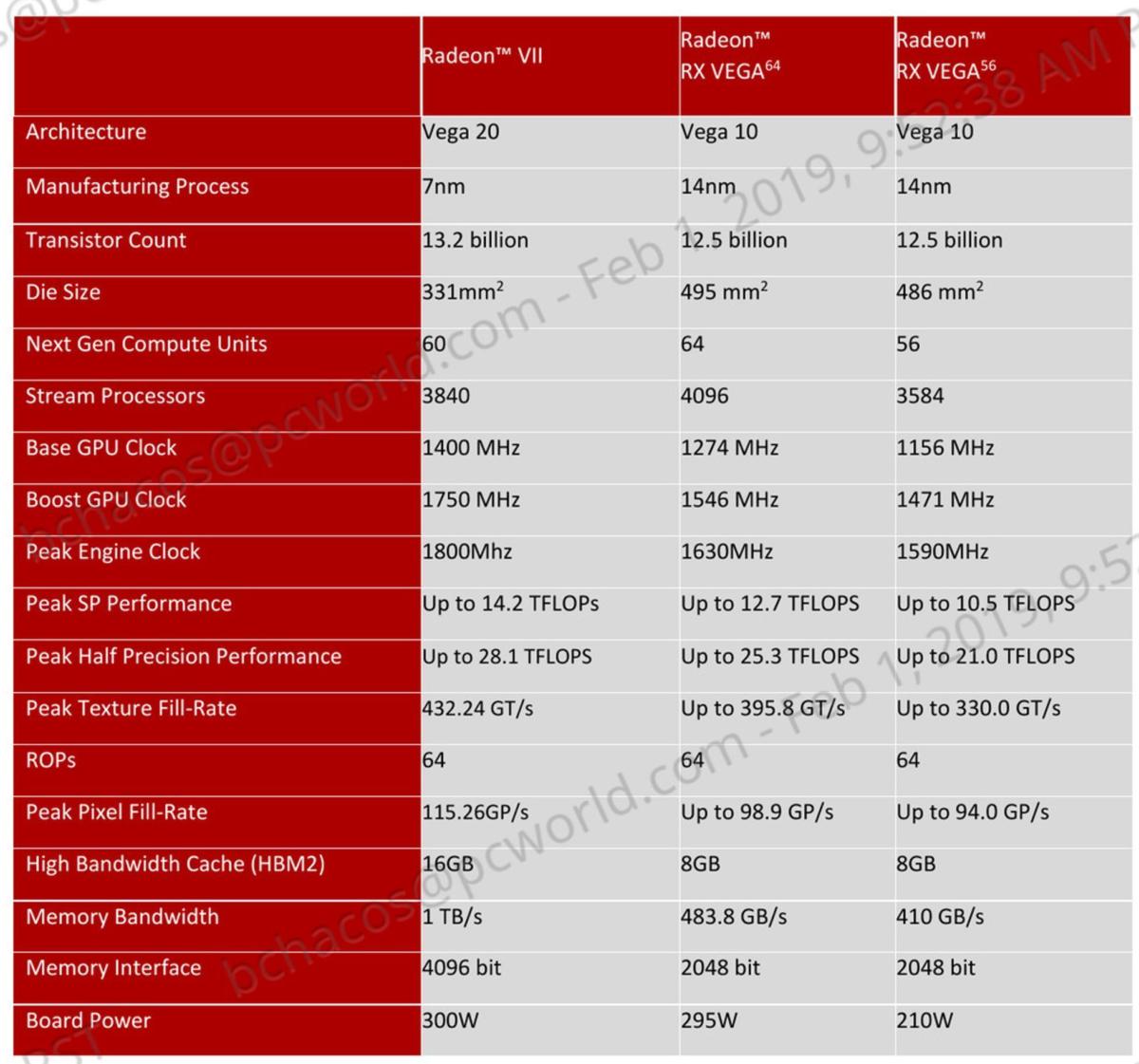 AMD
AMD Even though the Radeon VII harbors fewer moving processors than Vega 64, it demolishes its predecessor in sheer performance, as you'll see in our benchmarks later. In that respect are several reasons for that. First, AMD tuned Radeon VII to run at much higher clock speeds than Vega, with utmost boost clocks roaring ahead by more than 200MHz—No teeny-weeny exploit. (Note: The "bill engine clock" specification recorded in the chart above refers to "the highest achievable frequency" in certain content Creation workloads, while the traditional "boost clock" specification is for games.)
AMD also optimized the second-generation Vega architecture to provide lower latency, arsenic well as more bandwidth to the get in outturn units (ROPS). Those tweaks help improve gaming performance, while "increased vagrant point and integer accumulators" help boost results in work out workloads, a bighearted focus for AMD with Radeon VII.
 AMD
AMD AMD also tweaked temperature monitoring significantly in Radeon VII. Traditionally, AMD graphics cards reported and adjusted performance settled on a GPU temperature taken from a single sensor near a thermal junction rectifier. Forward-looking GPUs, by dividing line, come laden with temperature sensors: Radeon Cardinal contains a whopping 64 spread across the chip at—double the number on the Vega 64.
AMD's graphics card takes advantage of all that hardware with a spick-and-span "Junction Temperature" reading that handles thermal throttling and fan control victimization all the available information. AMD claims the switch offers more tried choking behavior and slenderly increased performance in thermally limited scenarios, like umteen (simply not all) gaming workloads.
You can have your cake and eat it too, though, equally Radeon Software's Wattman overclocking tool reports both the new Junction Temperature as well Eastern Samoa the casebook GPU temperature.
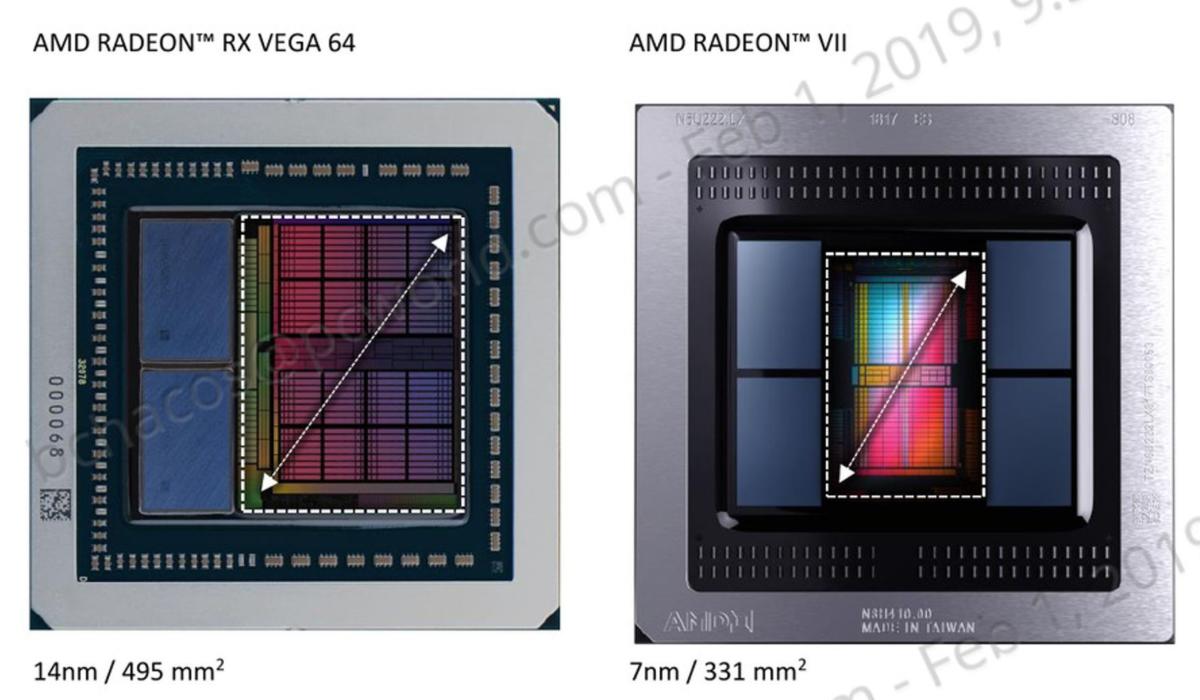 AMD
AMD AMD's Vega 64 chip vs Radeon Septet.
The shift from a 14nm to 7nm manufacturing process didn't just improve GPU execution. AMD managed to shrink the GPU die from 495 square millimeters in Vega 64 to 331 in Radeon VII. Atomic number 3 a result, the society crammed two more 4GB wads of HBM computer memory onto the buffalo chip, delivery the total number of stacks capable four and the total memory capacitance to 16GB. That's twice as much as you'll find in Nvidia's RTX 2080, and even 5GB much you'll find in the lofty $1,200 GeForce RTX 2080 Titanium.
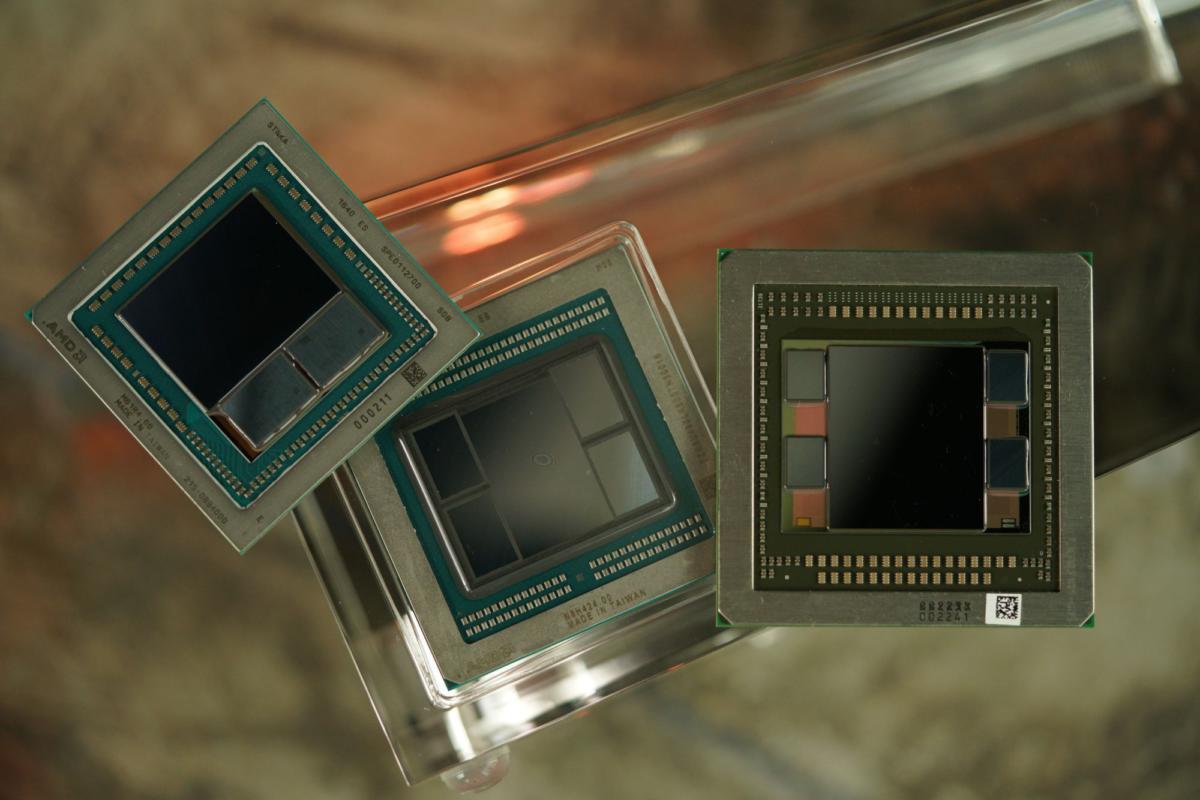 Gordon Mah Ung/IDG
Gordon Mah Ung/IDG Left to right wing: The HBM-equipped chips found in Lope de Vega 64, Radeon VII, and the Fury X.
Just as impressive: Radeon VII features a 4,096-bit memory user interface, compared to Vega 64's 2,048-bit interface, giving the card as astonishing overall memory bandwidth of 1 terabyte per second. Sweet holy moly. By comparison, Lope Felix de Vega Carpio 64 offers 484GBps of memory bandwidth; the GeForce RTX 2080 offers 448GBps; and the RTX 2080 Ti offers 616GBps.
Such lofty store capabilities offer benefits to gamers and content creators alike. Radeon VII shines brightest as a 4K gaming GPU, and games that offer 4K textures will often shovel in all the retentivity you can throw at it. A 16GB frame buffer offers abundant later-proofing if memory demands continue to expand, and it could also test advantageous today if a 4K game exceeds the 8GB buffer offered by the RTX 2080. When a game surpasses the onboard memory total of your telecasting card, it needs to tap into your much slower overall system memory instead, which posterior result in stutter-inducement frame wai. For content creators, editing 4K or 8K videos fanny monopolize enormous amounts of computer memory. Radeon VII can handle those workloads without breaking a sweat.
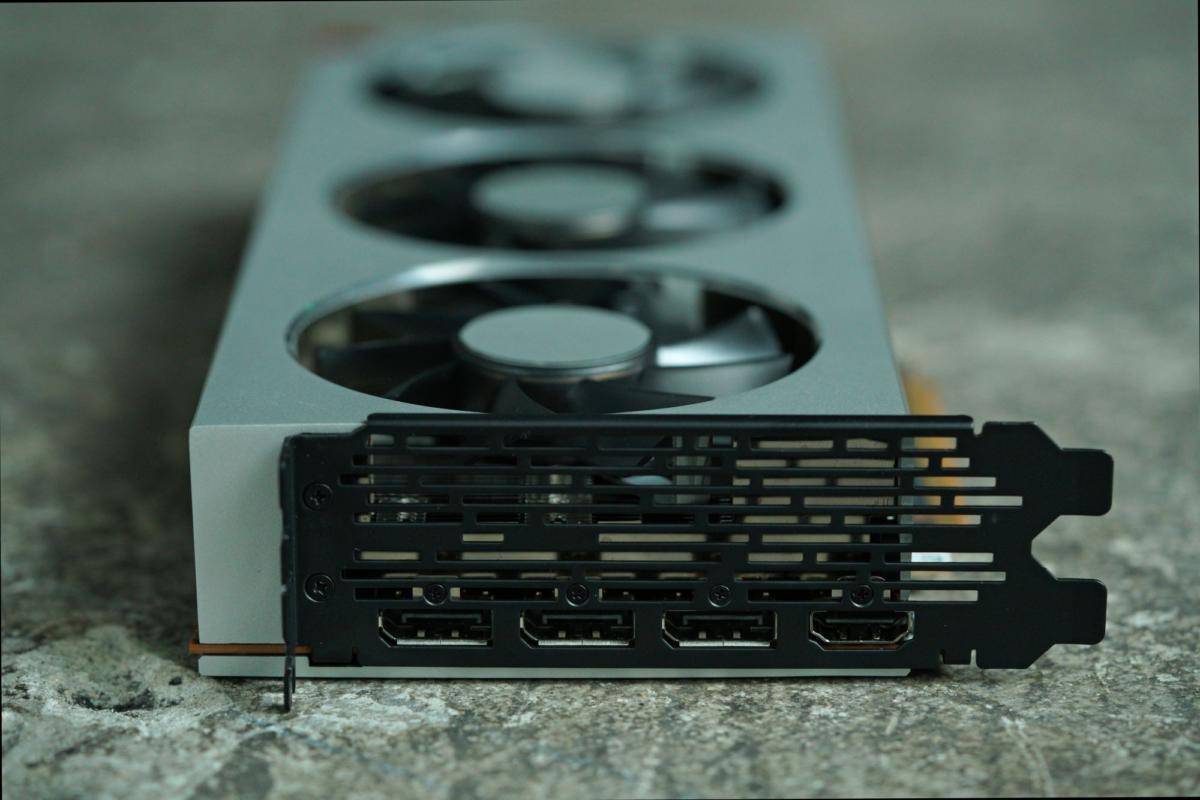 Gordon Mah Ung/IDG
Gordon Mah Ung/IDG Radeon 7 also comes loaded with connectivity options, in the pattern of an HDMI port and three DisplayPorts. It lacks the VirtualLink USB-C connector that debuted in Nvidia's RTX 20-serial publication GPUs, but virtual reality headsets that support the newly created standard don't exist sooner or later, anyway. The card requires a duo of 8-pin power connectors to supply the 300 watts of energy needed to fuel it—a mere 5W increase over the Vega 64, despite Radeon 7's prodigious operation uptick.
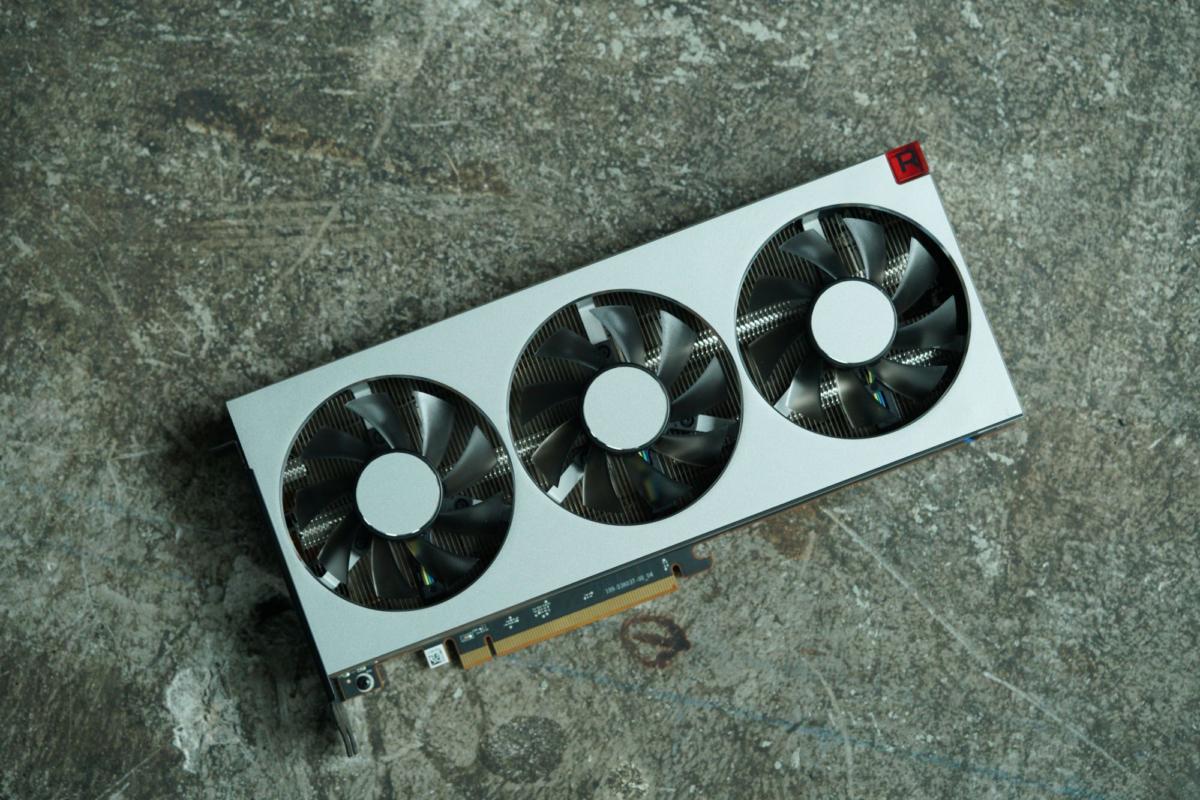 Gordon Mah Ung/IDG
Gordon Mah Ung/IDG The card itself looks absolutely beautiful from top to penetrate, returning to the unmitigated touched aluminum design introduced in the woefully uncommon Radeon RX Vega 64 Limited Edition. One key difference: While the Vega 64 Pocket-size Variation included a single blower-style fan on its shroud that helped expel vent of the back of your PC, the Radeon Septet follows in the footsteps of Nvidia's GeForce RTX Founders Variation card game by switching to a more longstanding multi-fan setup that pushes the heat dissipated by your GPU into your case instead. Three black fans adorn the shroud to assist in the endeavor.
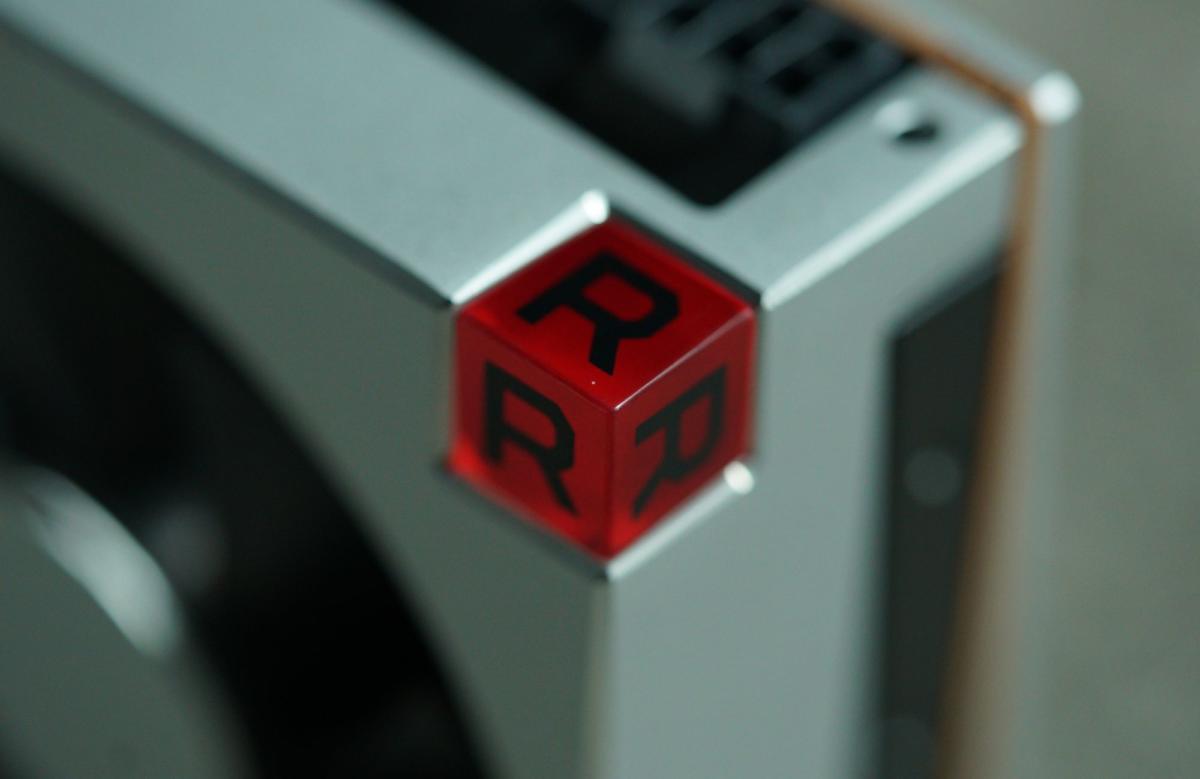 Gordon Mah Ung/IDG
Gordon Mah Ung/IDG A red-faced cube with a "Radeon" R lights up the outer corner of the artwork poster when information technology's running, an aesthetic matched aside an illuminated red Radeon logotype along the edge of the carte. You buns't change the gloss of the LEDs. Normally, that's not a plumping deal, just custom 3rd-party Radeon VII graphics cards aren't expected to be available when the card launches along February 7, so RGB fiends probably won't be healthy to get their situate in the go up-term.
As a stylish Radeon graphics carte, Radeon VII too supports FreeSync 2 HDR, virtual super resolution, the Radeon Overlay, per-secret plan overclocking, and all the other nifty features toughened into AMD's superb Radeon Package Adrenalin 2019 edition. For a limited metre, AMD volition also toss in three free games—The Class 2, Irritate Whitethorn Cry 5,andResident Evil 2—when you buy out the Radeon Septenary.
But enough or so the technical details. On to the games!
Next paginate: Test system constellation, benchmarks gaming begin
Our test system
Our dedicated graphics carte test system is packed with some of the fastest complementary components available, to put any potential difference performance bottlenecks squarely on the GPU. Most of the ironware was provided by the manufacturers, just we purchased the tank and storage ourselves.
- Intel Burden i7-8700K processor ($360 on Amazon)
- EVGA CLC 240 closed-loop fluent tank ($120 on Amazon)
- Asus Maximus X Hero motherboard ($260 on Amazon)
- 64GB HyperX Piranha RGB DDR4/2933 ($416 for 32GB on Amazon)
- EVGA 1200W SuperNova P2 power append ($180 happening Amazon)
- Corsair Crystal 570X RGB case, with front line and top panels removed and an extra rear fan installed for improved airflow ($170 along Amazon)
- 2x 500GB Samsung 860 EVO SSDs ($100 on Amazon)
To see how the $700 Radeon Heptad lots up against the current competition, we'ray comparing IT to Nvidia's $500 GeForce RTX 2070, $800 GeForce RTX 2080, and $1,200 GeForce RTX 2080 Ti Founders Edition graphics cards. We'atomic number 75 also including benchmarks for the $740 PNY GeForce GTX 1080 Ti and AMD's $500 Radeon RX Vega 64 source card.
Each game is tested using its in-game bench mark at the highest possible graphics presets. We disenable VSync, draw up pace caps, and all GPU vendor-specific technologies—like AMD TressFX, Nvidia GameWorks options, and FreeSync/G-Sync, and we enable profane anti-aliasing (TAA) to thrust these high-end cards to their limits. If any background differs from that, we'll mention it.
AMD Radeon Heptad play benchmarks
Strange Brigade
Let's kick things off with Imported Brigade ($50 on Low), a cooperative third-person shooter where a squad of adventurers blasts through hordes of mythological enemies. It's a scientific showcase, built around the next-gen Vulkan and DirectX 12 technologies and infused with features like HDR support and the ability to toggle asynchronous figure out connected and murder. IT uses Rebellion's custom Azure locomotive. We test with async compute forth.
Editor's note: The graphical record below is labeled incorrectly. The blue line indicates 4K performance, the red line is 1440p performance, and William Green is so 1080p.
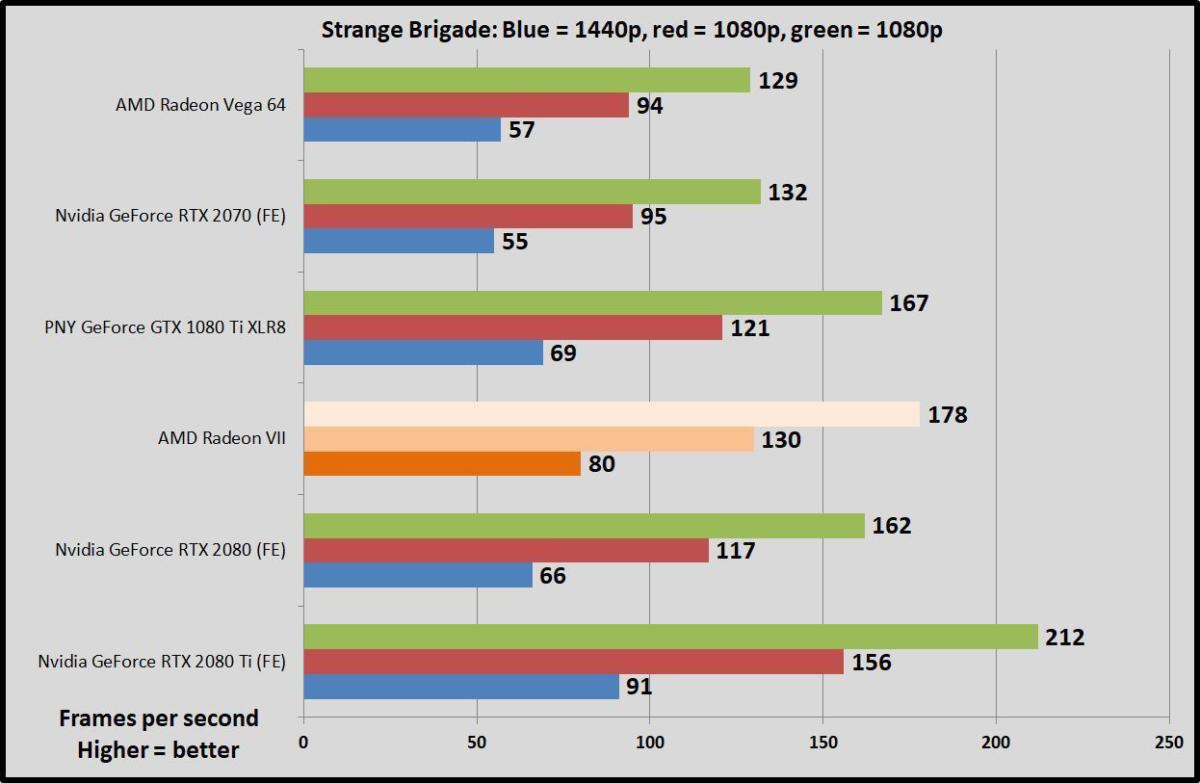 Brad Chacos/IDG
Brad Chacos/IDG Spoiler alert: Radeon VII puts in its strongest performance by far here, easily outclassing both the PNY GTX 1080 Atomic number 2 and the Nvidia RTX 2080 FE—two similarly priced graphics card game—by to a higher degree 10 frames per second across every last resolutions, and toppling the older Radeon RX Vega 64 by ended 40 percent at 4K firmness of purpose.
Shadow of the Tomb Raider
Shadow of the Tomb Raider ($60 connected Humble) concludes the reboot trilogy, and it's perfectly gorgeous—even the progressive GeForce RTX 2080 Ti barely manages to average 60 fps with all the bells and whistles turned on at 4K resolving. Square Enix optimized this gimpy for DX12, and recommends DX11 only if you're victimisation older hardware operating room Windows 7, so we test with that. Shade of the Grave Raider uses an enhanced interlingual rendition of the Foundation engine that also powered Rise of the Tomb Raider.
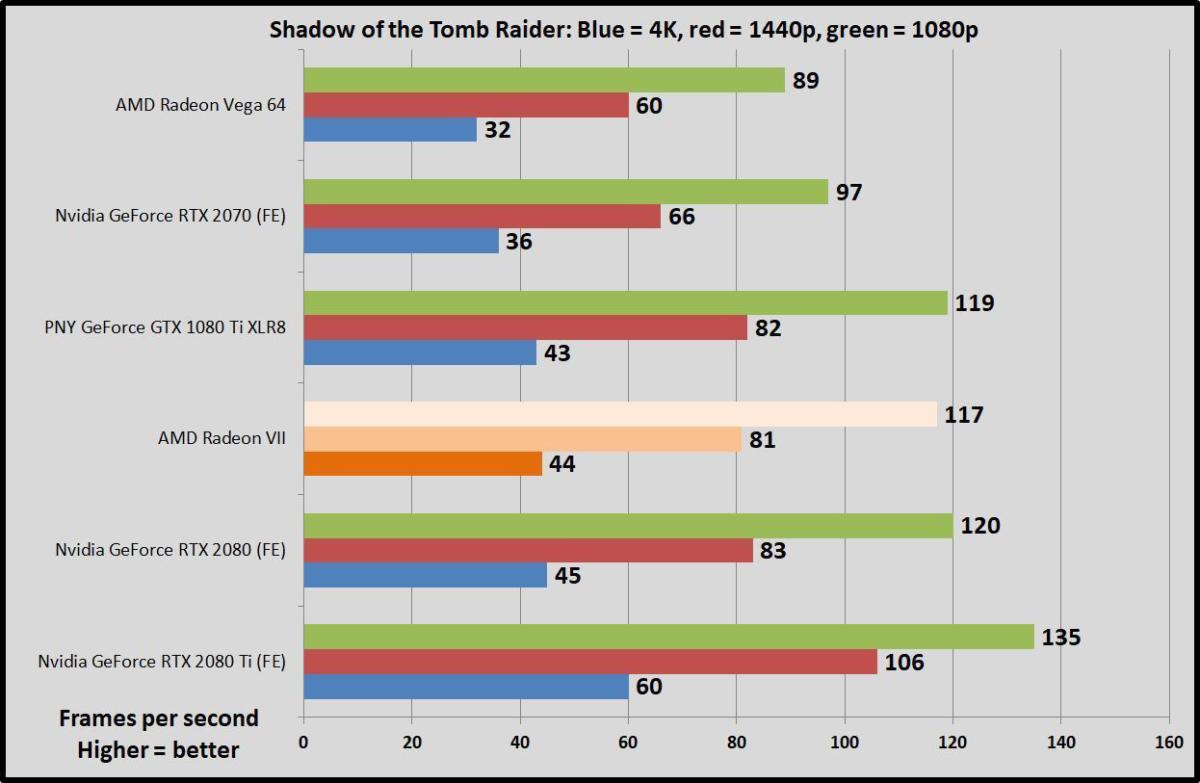 Brad Chacos/IDG
Brad Chacos/IDG The three $700 graphics cards retir virtually identical performances, including the Radeon Septenary. Again, the newer placard outclasses Vega 64 by just deficient of 40 percent.
Far Cry 5
Lastly, a DirectX 11 game! Utmost Call out 5 ($60 on Humble) is steam-powered by Ubisoft's long-established Dunia railway locomotive. IT's even as gorgeous as its predecessors were, and still more fun.
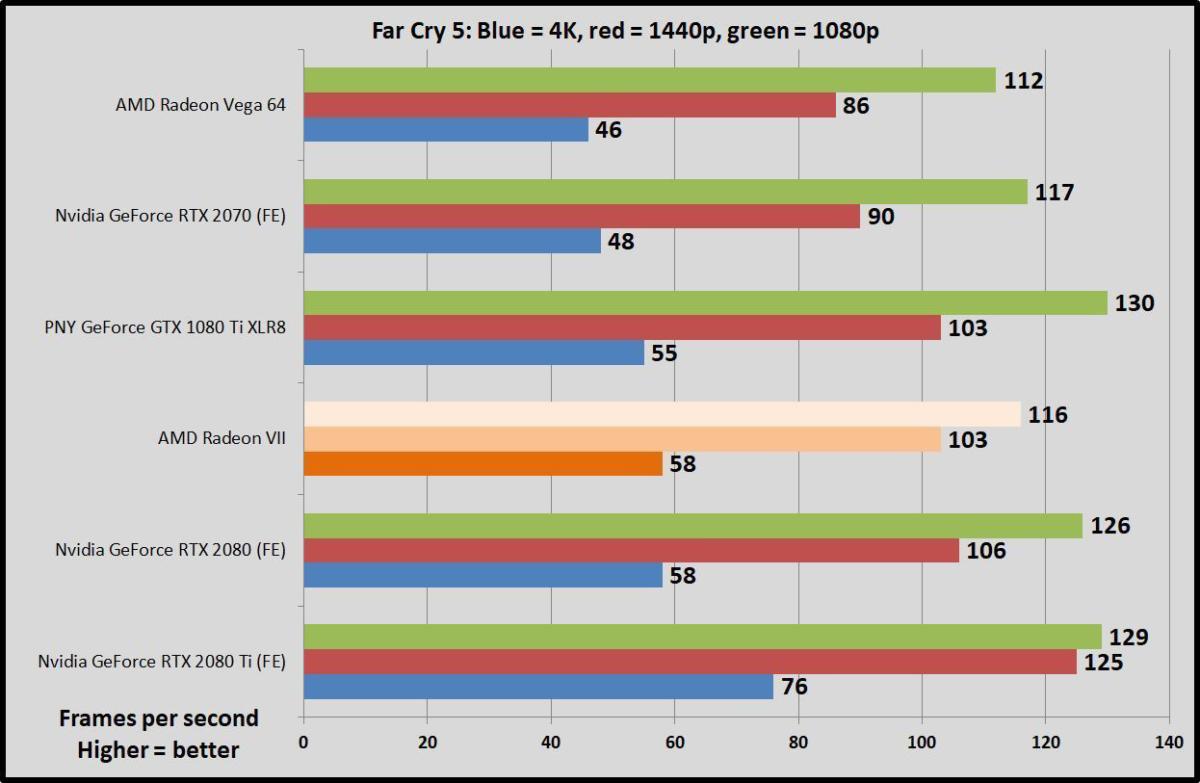 Brad Chacos/IDG
Brad Chacos/IDG Radeon VII once over again manages to knack tough with Nvidia's powerful pair of $700 GPUs, flirting with 60 frames per second smooth with everything cranked at 4K resolution. Its leave over Vega 64 greatly diminishes therein game though, at just over 26 pct faster.
Next page: Gaming benchmarks continue
Ghost Recon Wildlands
Move terminated, Crysis. If you crank all the graphics options up to 11, look-alike we do for these tests, Ghostwriter Recon Wildlands ($50 on Humble) and its AnvilNext 2.0 engine absolutely melts GPUs.
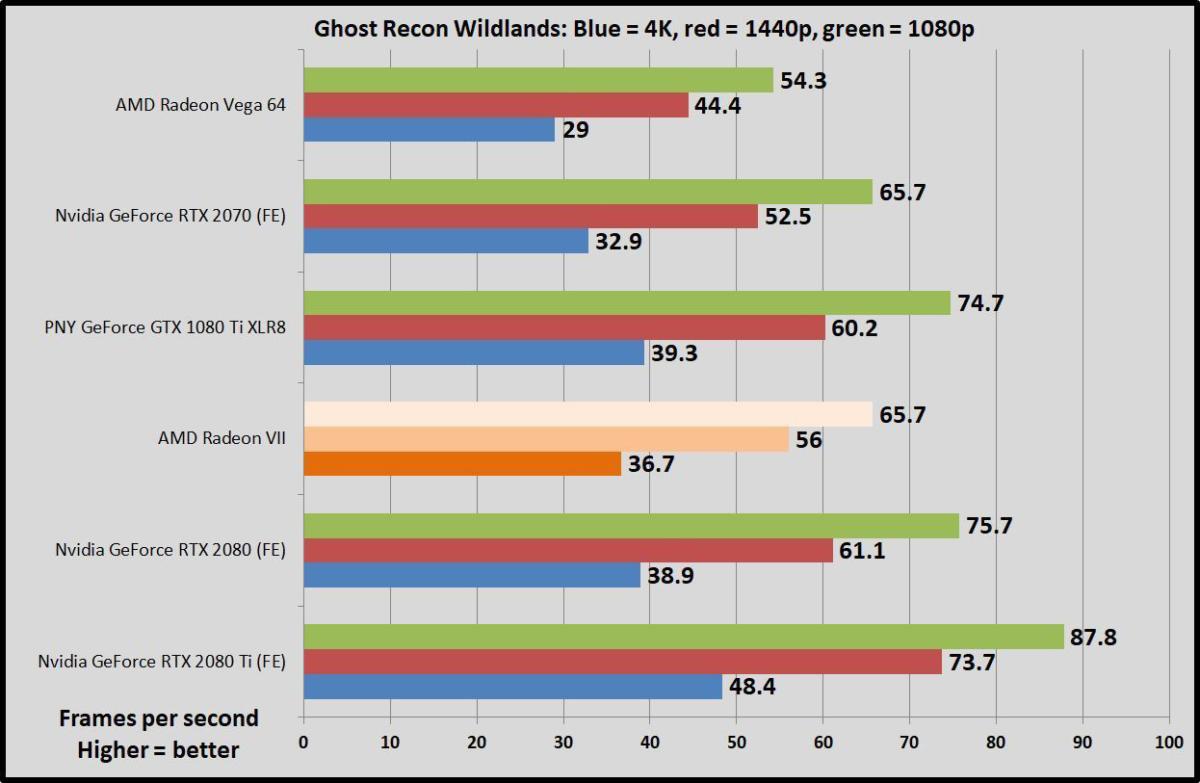 Brad Chacos/IDG
Brad Chacos/IDG Ghost Recon Wildlands also prefers Nvidia's GPU architecture generally, putting AMD's new circuit card very slenderly behind the GTX 1080 Cordyline terminalis and RTX 2080 in raw frame rates. In price of substantial-world experience IT's effectively a dead heat, though. Radeon Septenary erst again claims a roughly 26 percent victory over AMD's Vega 64.
Middle-earth: Shadow of War
Midriff-earth: Dwarf of Warfare ($50 on Humble) adds a strategic level to the series' reverend core group gameplay loop, adapting the Nemesis system to let you create an army of personalized Orc commanders. It plays the likes of a title-holder on Personal computer, too, thanks to Monolith's custom LithTech Hangbird engine. We use the Extremist graphics preset but drop the Shadow and Texture Quality settings to Richly to avoid exceeding 8GB of VRAM usage in our testing scenario, because graphics cards that surmount 8GB of capacity are rarefied so. Radeon Seven's 16GB frame pilo would easily LET you crank those settings stake up if you wanted, though.
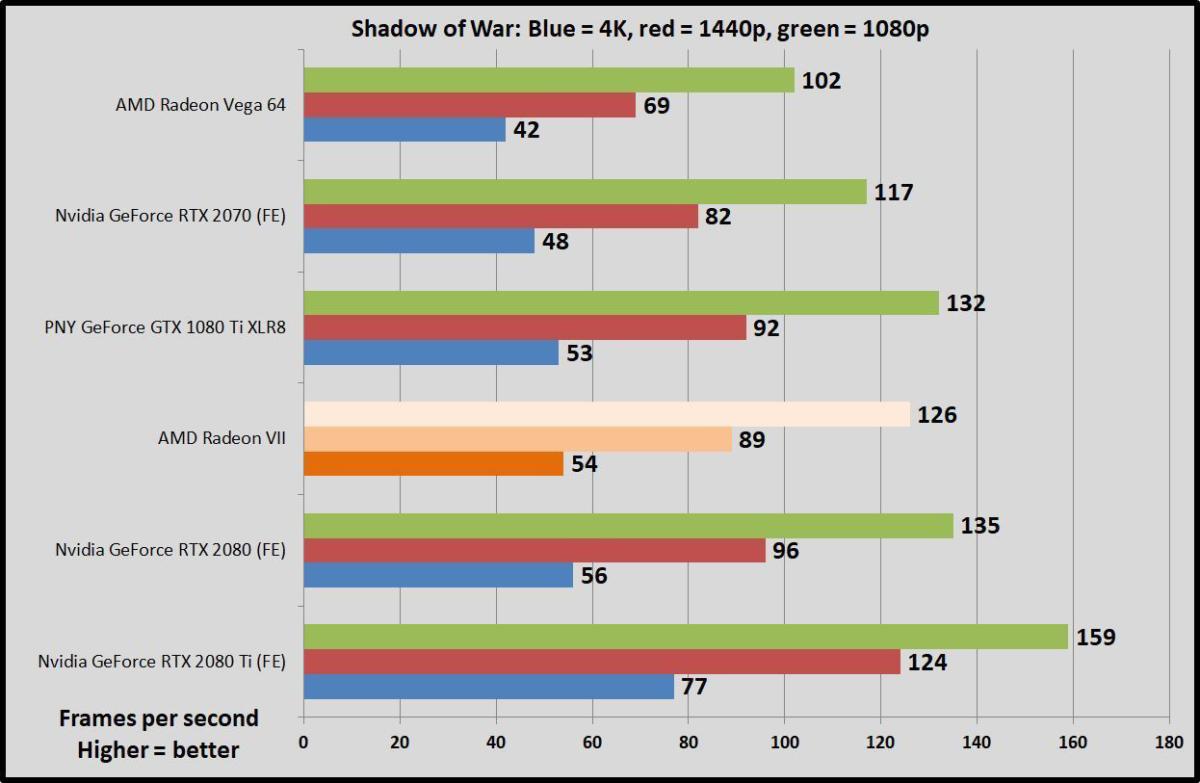 Brad Chacos/IDG
Brad Chacos/IDG Once over again, while the Radeon VII technically falls behind Nvidia's similarly priced GPUs by a few frames per second, they offer nigh indistinguishable real-humans experiences.
F1 2018
The latest in a long line of successful games, F1 2018 ($60 on Humble) is a benchmarking stone, supply a wide align of both graphic and benchmarking options—making information technology a much more reliable option that the Forza serial publication. It's well-stacked on the fourth version of Codemasters' buttery-unruffled Ego back engine. We exam two laps along the Australia trend, with clear skies.
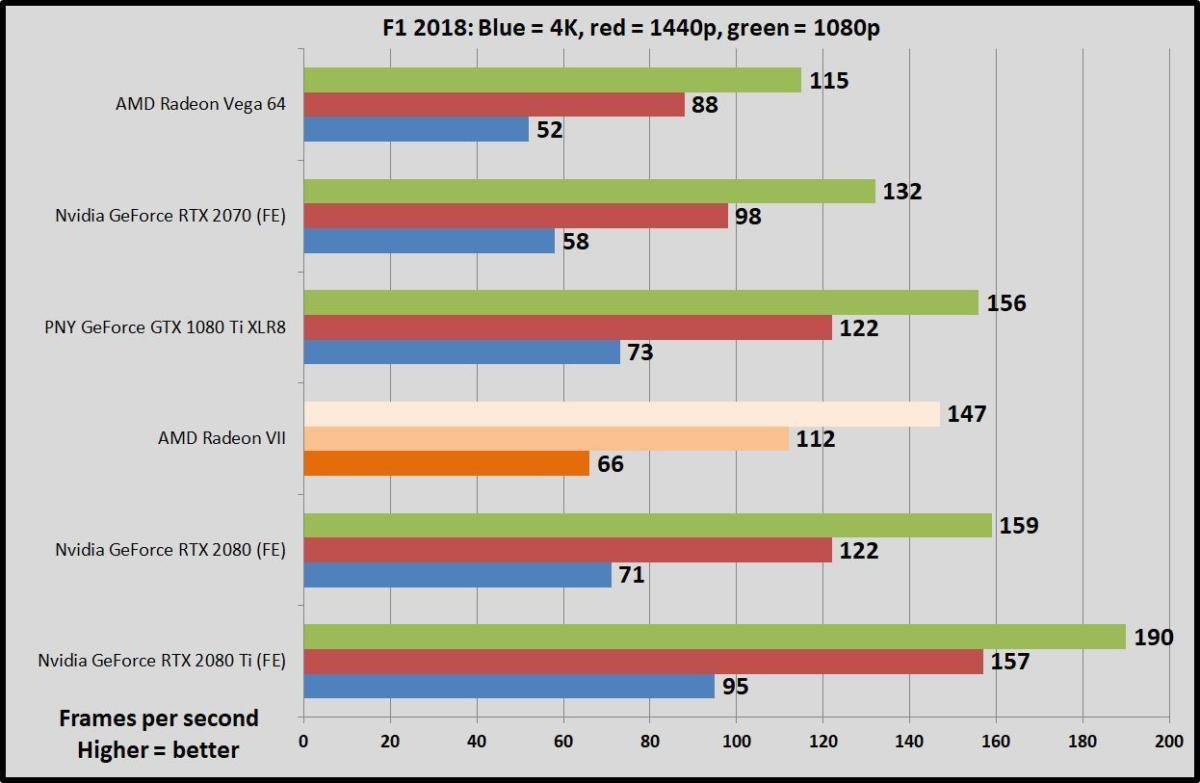 Brad Chacos/IDG
Brad Chacos/IDG The Radeon VII lags behind the GTX 1080 Titanium and RTX 2080 by a more noticeable 7.5 and 10.6 percent, respectively, at 4K resolution. Nevertheless, AMD's add-in easily delivers buttery-smooth 4K gaming that surpasses the 60-fps Au standard.
Next page: Gaming benchmarks continue
Ashes of the Singularity: Escalation
Ashes of the Singularity ($40 on Humble) was one of the very first DX12 games, and it remains a flagbearer for the technology to this daylight thanks to the extreme scalability of Oxide Games' next-gen Nitrous railway locomotive. With hundreds of units onscreen simultaneously and some serious graphics personal effects in play, the Crazy predetermined can gain artwork cards sweat. Ashes runs in both DX11 and DX12, but we only test in DX12, atomic number 3 it delivers the best results for both Nvidia and AMD GPUs.
Editor's note: The graph to a lower place is labeled incorrectly. The blue sky line indicates 4K performance, the red line is 1440p operation, and green is so 1080p.
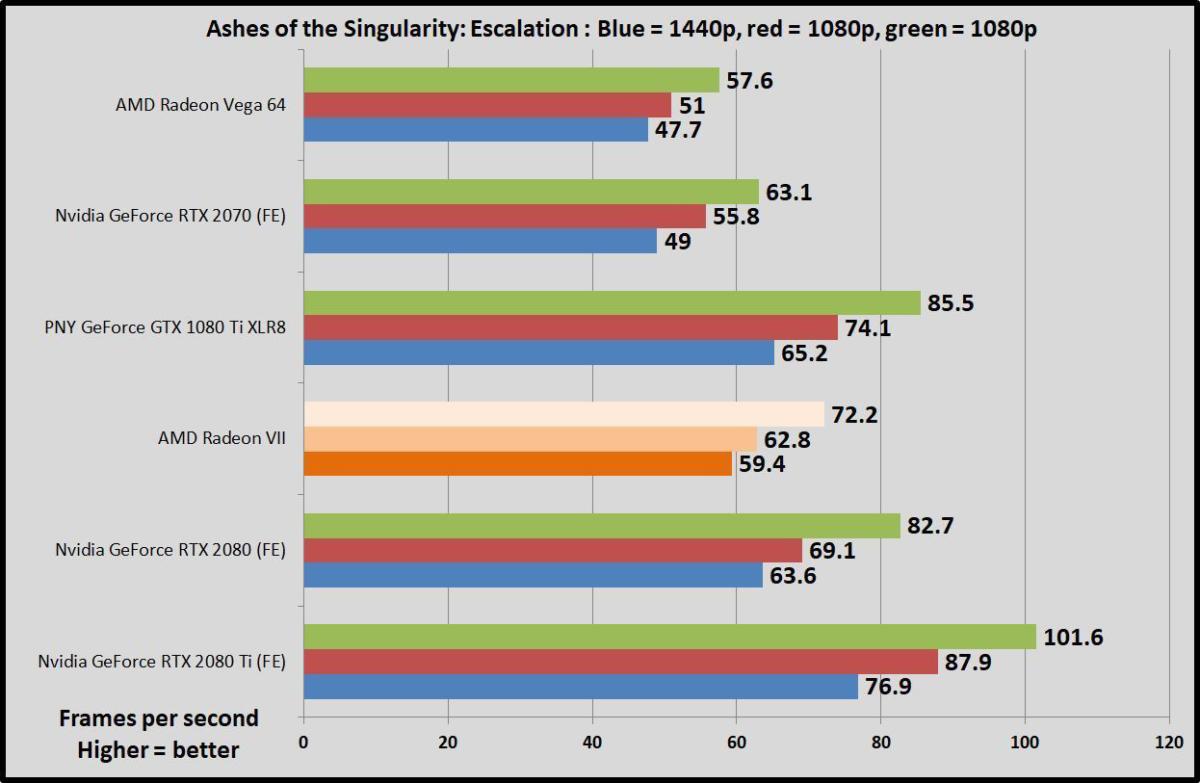 Brad Chacos/IDG
Brad Chacos/IDG This is another game where the Radeon VII trails Nvidia's GPUs aside 6 Beaver State 7 percent at 4K resolution. That shouldn't be real noticeable to the human being eye, and AMD's visiting card once more has zero problems hovering around 60 FPS, even with all the eye candy cranked.
GTA V
We're going to wrap things rising with a yoke of older games that aren't real visual barn-burners, simply still tip the Steam charts day in and day out. These are games that a lot of people play. First in the lead: Thousand Theft Auto V ($30 on Humble) with all options sour to Very High, all Advanced Graphics options omit outspread shadows enabled, and FXAA enabled. GTA V runs on the RAGE engine and has received strong updates since its initial launch.
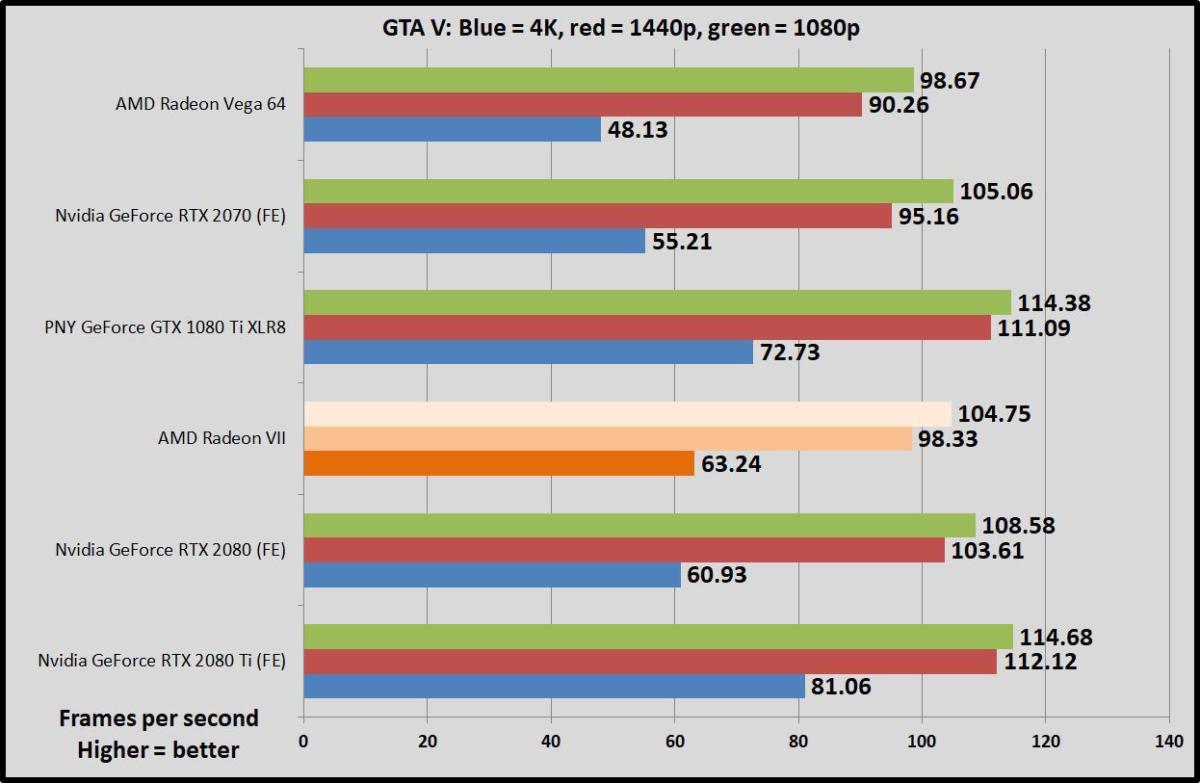 Brad Chacos/IDG
Brad Chacos/IDG This game tends to immensely prefer Nvidia GPUs, and the Radeon VII trails the older GTX 1080 Ti by a decent sum of money. Just interestingly, thanks to tweaks in the GeForce RTX 2080's technological constellation, Radeon VII comes out ahead of it at 4K resolution. Nvidia's modern alternative takes back the lead if you shift the resolution down to 1440p or 1080p, though. Radeon Sevener is also 31 percentage faster than Lope de Vega 64.
Rainbow Six Siege
At last, LET's take a peek at Rainbow Six Military blockade ($40 on Lowborn), a game whose consultation just keeps on growing, and incomparable that still feels like the only truly next-gen shooter after all these years. Like Ghost Recon Wildlands, this game runs along Ubisoft's AnvilNext 2.0 engine, but Rainbow Six Siege responds particularly well to graphics card game that lean along async figure out features.
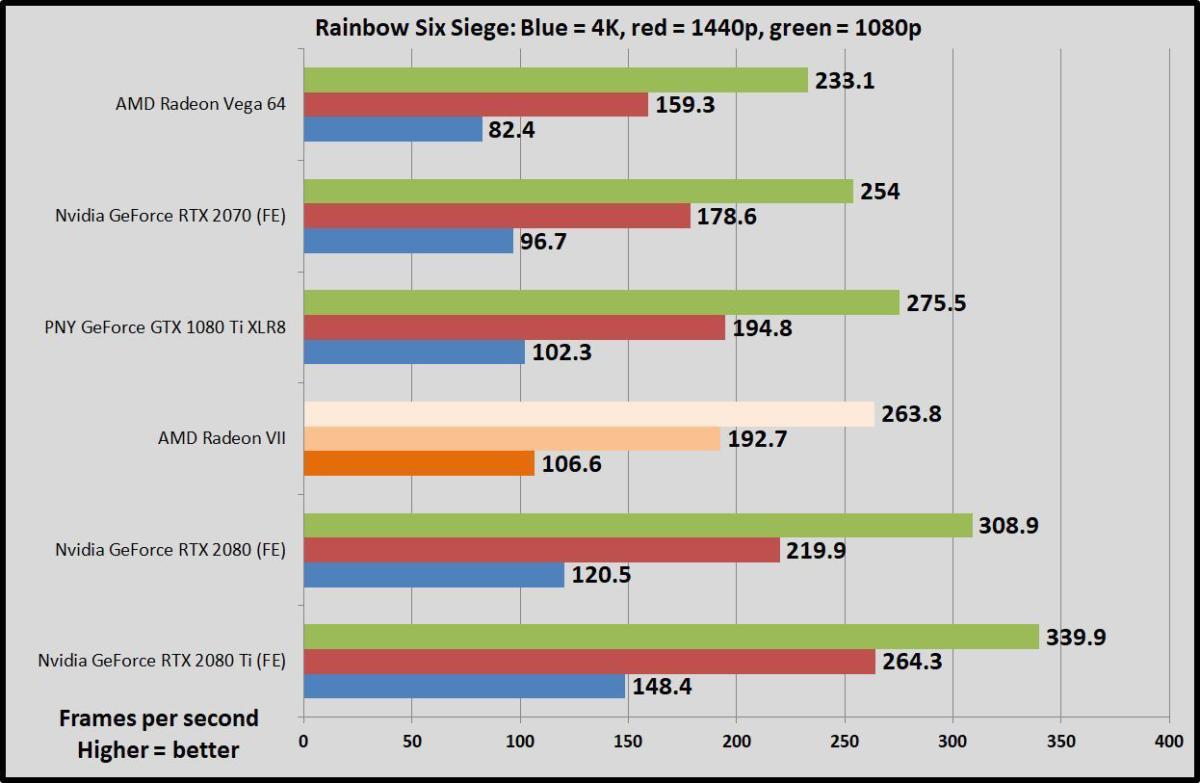 Brad Chacos/IDG
Brad Chacos/IDG Nvidia greatly enhanced the async work out capabilities of its graphics architecture in the new RTX 20-series lineup. As a result, the RTX 2080 opens up a huge lead over Radeon VII, even though AMD's new card performs fairly evenly with the older GTX 1080 Si. If you'atomic number 75 a Siege fan, you'll want to choose for RTX over RVII.
Next page: Self-satisfied universe benchmarks
AMD Radeon VII content origination benchmarks
AMD wants to tout the Radeon VII's content creation chops, likewise. So for this recapitulation, my colleague Gordon Mah Ung ran additional tests focused on this use case.
Our Contented Conception Testbed
For content creation, we used a machine a trifle break suited to actual content creation artists: AMD's 32-core Threadripper 2990WX C.P.U. in an MSI X399 MEG Creation motherboard. The build used Windows 10 RS5 and 32GB of DDR4/3200 in quad-transmission channel configuration. The OS was installed along a HyperX SATA SSD with a Plextor M8Pe SSD for workloads that might be disk-bound. We used the latest ready drivers for the Radeon Seven and the GeForce RTX 2080 Founders Edition card. OpenCL was used for the Radeon VII, while the GeForce ran connected CUDA.
Our first test uses Adobe Premiere Creative Cloud 2019 to exportation a 4K video exploitation the the H.264 YouTube 4K preset and the liquid ecstasy hand over quality option. The number one serving of the telecasting is mostly a straight encode, while the latter half layers on GPU-taxing graphics and B-roll. The entire clip is also color corrected.
The results gave the Radeon VII a very small lead, but let's call it a tie. For the most part, these results match functioning data from AMD for 4K happy where the two cards are nearly even. We should note that AMD says using 8K resolution video in reality opens the gap more.
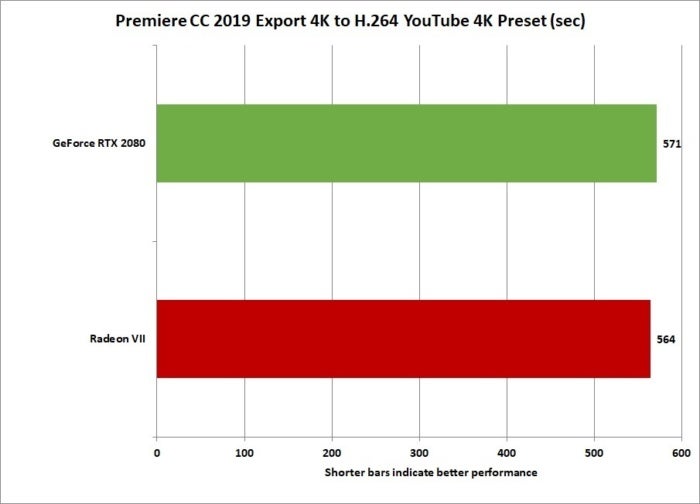 IDG
IDG Using Adobe Premiere Milliliter 2019 to export a 4K resolution file with discolor rectification and graphics overlays.
Our next test used the Chaos Group's V-ray benchmark to measure performance when interpreting a ray-traced scene on the GPU. The Radeon again has a small lead of about five percent.
The elephant in the room. however, are those two words: ray traced. While the current V-ray benchmark does not support Microsoft's DirectX Beam and by extension, Nvidia's RTX, it will. And once that happens, you can expect the functioning win to shift in a big way to Nvidia.
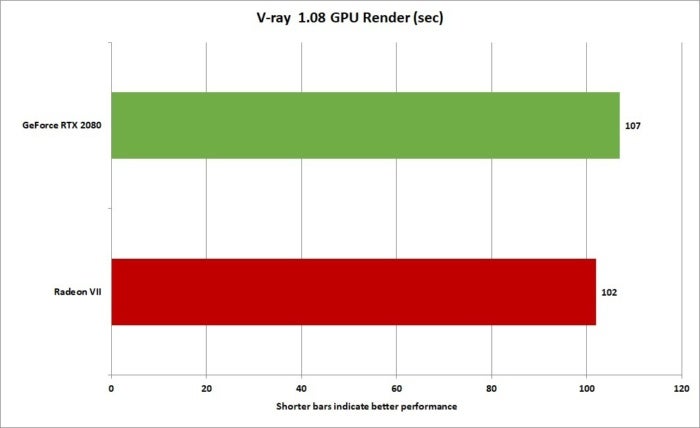 IDG
IDG The Chronos Group's V-Light beam GPU test measures performance of a GPU when used for rendering ray traced images. The Radeon VII has a slight edge finished the GeForce RTX 2080 here.
One could argue, however, that straight up OpenCL performance matters more in the moment. To measure OpenCL performance we used LuxMark 3.1 (available here) to approximate execution of some the Radeon VII and the GeForce RTX 2080.
The success: Radeon Seven with much to-do. LuxMark (based happening LuxRender) gave the Radeon VII everything from as little as 10 percent to 38 percent vantage over the GeForce RTX 2080.
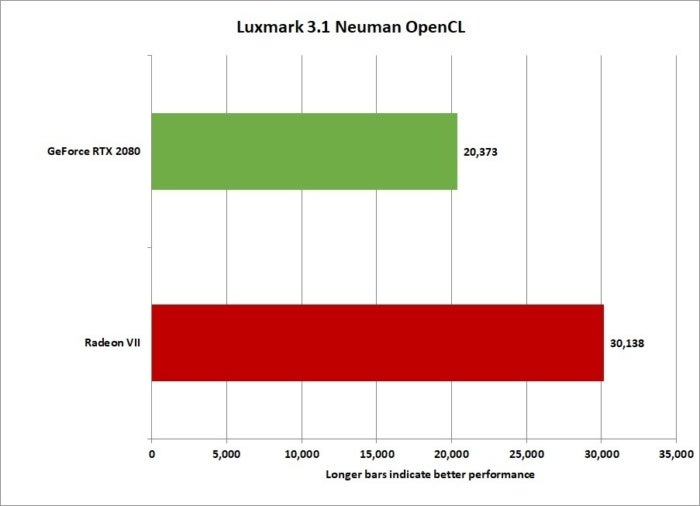 IDG
IDG Single area where the Radeon VII flexes its muscles is in LuxMark's OpenCL test. We found the Radeon VII outperformed the GeForce RTX 2080 from 11 percent to 38 percent in the three available workloads.
Radeon VII Mental object Creation Conclusion
Mostly, we'd say the Radeon VII pretty such equals or exceeds the RTX 2080 in several content introduction tasks. But the answer is never that simple. Like games, complacent creative activity engines tend to be fairly specialized. Rather than simply saying one is the success, you should focus on which is the achiever for what you do. —Gordon Mah Ung
Next page: Power, thermals, dissonance, and synthetic benchmarks
AMD Radeon VII power attractor, thermals, and noise
We likewise tested Radeon VII using 3DMark's extremely respected Fire Strike logical bench mark. Fire Strike runs at 1080p, Fire Strike Extreme runs at 1440p, and Fire Work stoppage Ultra runs at 4K resolution. All get in the cookie-cutter scene, but with more violent graphical effects as you move up the scale, so that Utmost and Ultra flavors stress GPUs even more. We record the graphics score to eliminate variance from the Processor.
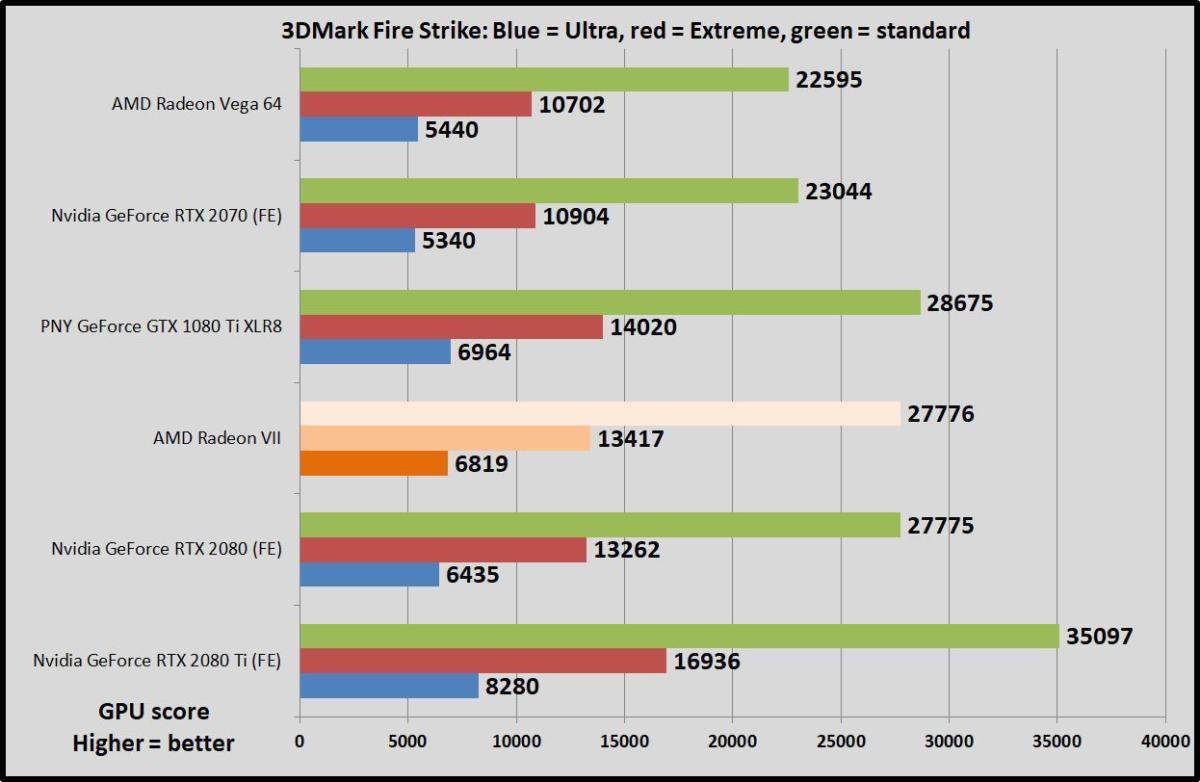 Brad Chacos/IDG
Brad Chacos/IDG Yep, everything falls about where you'd expect after observing the gaming benchmarks, which is always the character with Fire Come across. It's a good "sanity check" creature.
We tryout ability draw aside looping the F1 2018 benchmark for about 20 transactions afterwards we've benchmarked everything else, and noting the highest reading on our Watts Up Pro meter. The initial part of the speed, where all competing cars are onscreen at the same time, tends to be the about demanding portion.
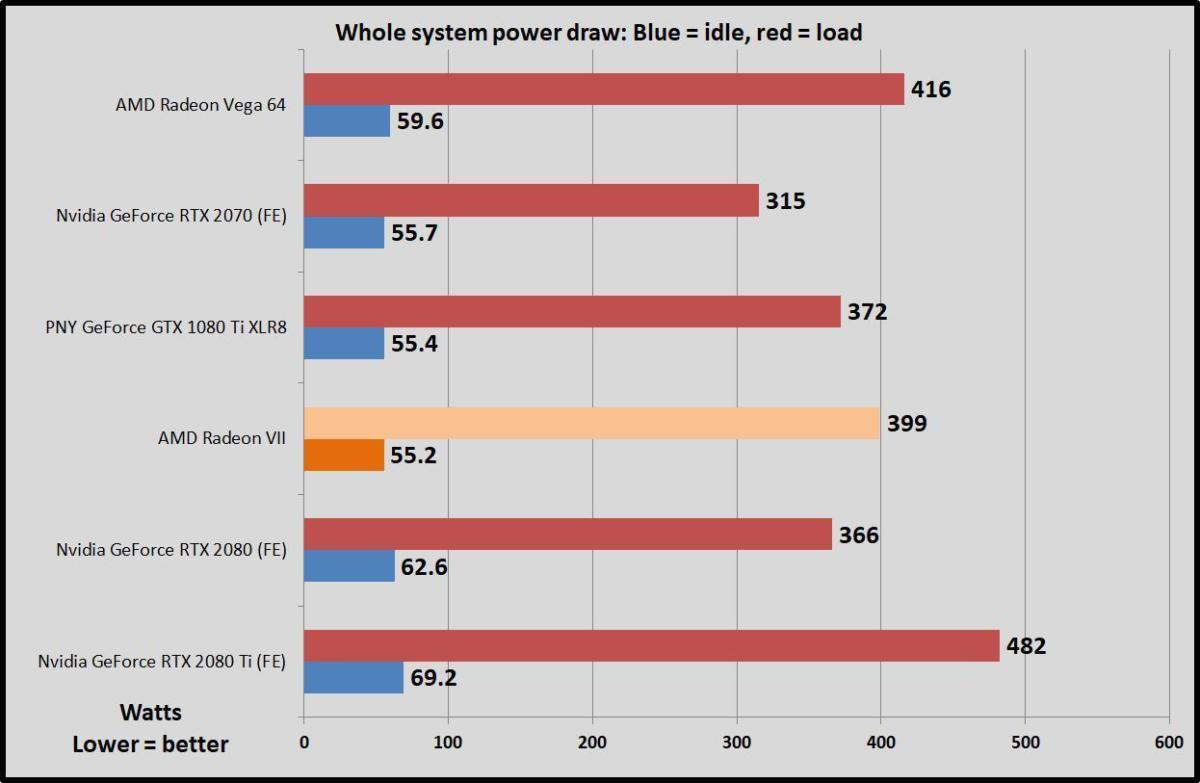 Brad Chacos/IDG
Brad Chacos/IDG Moving to the 7nm work has done wonders for Vega's power efficiency. IT's still not quite on a par with Nvidia's results, but information technology's a close enough that efficiency can't beryllium considered an AMD drawback any longer. It's a colossal improvement over the hot, hungry Vega 64.
We typically test thermals by leaving HWInfo's sensor monitoring tool around open during the F1 2018 5-lave power draw test, noting the highest maximum temperature at the goal. Merely third-party monitoring software like HWInfo and SpeedFan harbour't been oriented to handgrip the way AMD tweaked Radeon Heptad's temperature monitoring, and presentation the newer (and some high) Junction Temperature rather than the traditional GPU temperature reading. Because all early art card game list the GPU temperature, we penury to test that to the right way compare performance. Intrinsically, we deviated from using HWInfo on the Radeon VII and measured the GPU temperature using AMD's Wattman tool instead.
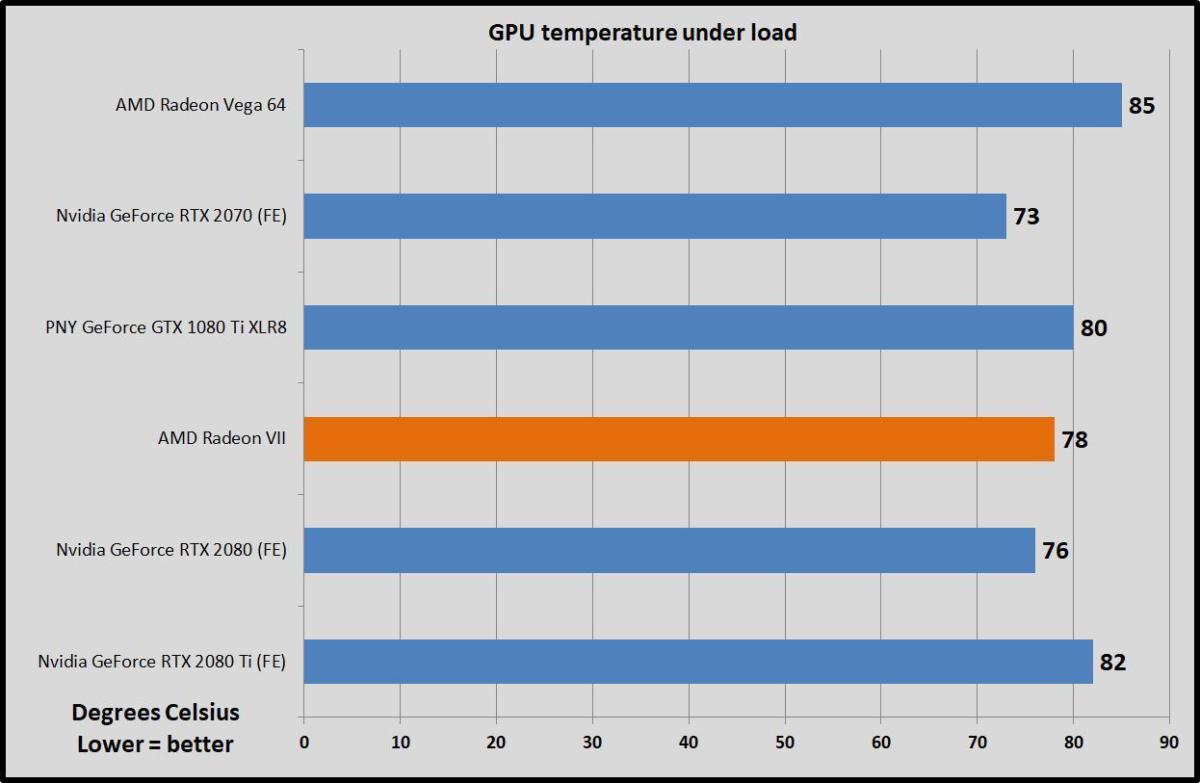 Brad Chacos/IDG
Brad Chacos/IDG Assumptive Wattman's readings are accurate—and they've always tracked with HWInfo and SpeedFan in the past—then Radeon VII erstwhile again crushes its hot-blooded predecessor, Vega 64. Superior out at 78 degrees Celsius (172.4 degrees Gabriel Daniel Fahrenheit) under encumbrance, AMD's fan-full 7nm GPU runs at a utterly acceptable temperature. Heck, it's chillier than the PNY GTX 1080 Ti's customized ice chest. No complaints here.
You can definitely hear the Radeon Septet working when information technology's below wide load, only not enough to be distracting. At one time once again, IT's a big advance over the Vega 64's banshee-like screaming, though the GeForce RTX 2080 Founders Version runs noticeably quieter.
Next pageboy: Should you buy the AMD Radeon VII?
Should you buy the AMD Radeon VII?
If you're hunt for a high-performing graphics card capable of playing games with few visual compromises at 4K resolution, operating theatre ultra-fast 1440p, then you should definitely moot the Radeon VII—especially if the sky-high $1,200 cost tag for Nvidia's GeForce RTX 2080 Ti scares you off. Don't bother upgrading to this card if you already have a GTX 1080 Ti, though.
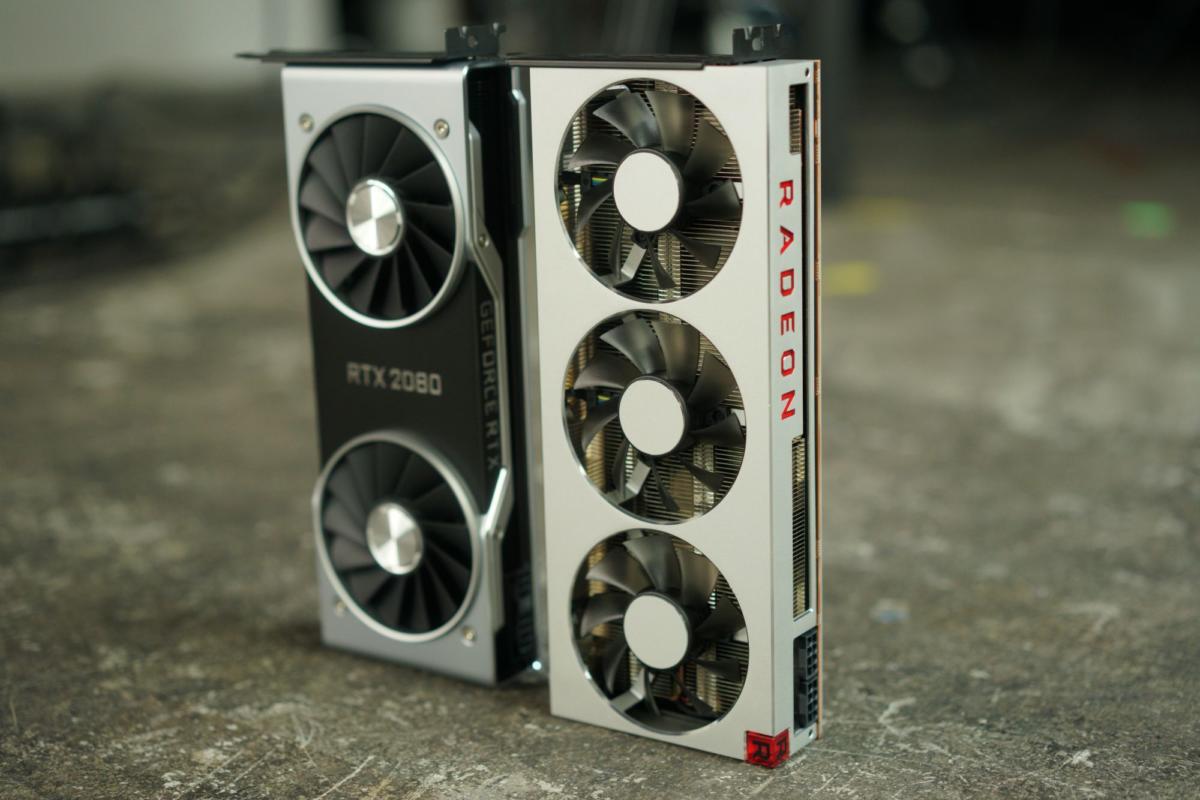 Gordon Mah Ung/IDG
Gordon Mah Ung/IDG Nvidia's GeForce RTX 2080 vs. AMD's Radeon Sevener
The GeForce RTX 2080 and Radeon VII each cost $700 (though the overclocked Founders Edition we tested costs $800) and have similar real-human race performance, though the Radeon VII lags slightly behind total, and the frame rate differences are extreme in some games. Radeon VII pounds the RTX 2080 Founders Edition in Weird Brigade, and the RTX 2080 pounds AMD's card in Rainbow Six Beleaguering and Ashes of the Singularity. Performance is a wash away in most games, simply the RTX 2080's lead expands if you drop all the way down to an ultra-fast 1080p monitor. Nvidia's GPU holds a small vantage in big businessman efficiency and thermals every bit well, merely the differences 'tween the two cards are once more negligible.
So what about the standout features of each?
Nvidia's recent FreeSync adoption eliminated a compelling reason to opt for Radeon cards over GeForce. Still, AMD loaded Radeon VII with some heart-catching extras. Radeon Septenary holds a diminutive-to-large performance reward over the RTX 2080 in the content foundation benchmarks we tested—Eastern Samoa expected, surrendered how fortified Radeon architectures have typically performed in reckon workloads. One thing to consider though: Nvidia's CUDA is much more favorite for compute workloads than the OpenCL tools AMD relies on, and if you need to perform ray tracing, the RTX 2080's dedicated RT cores could give that card a boost in ray tracing tasks.
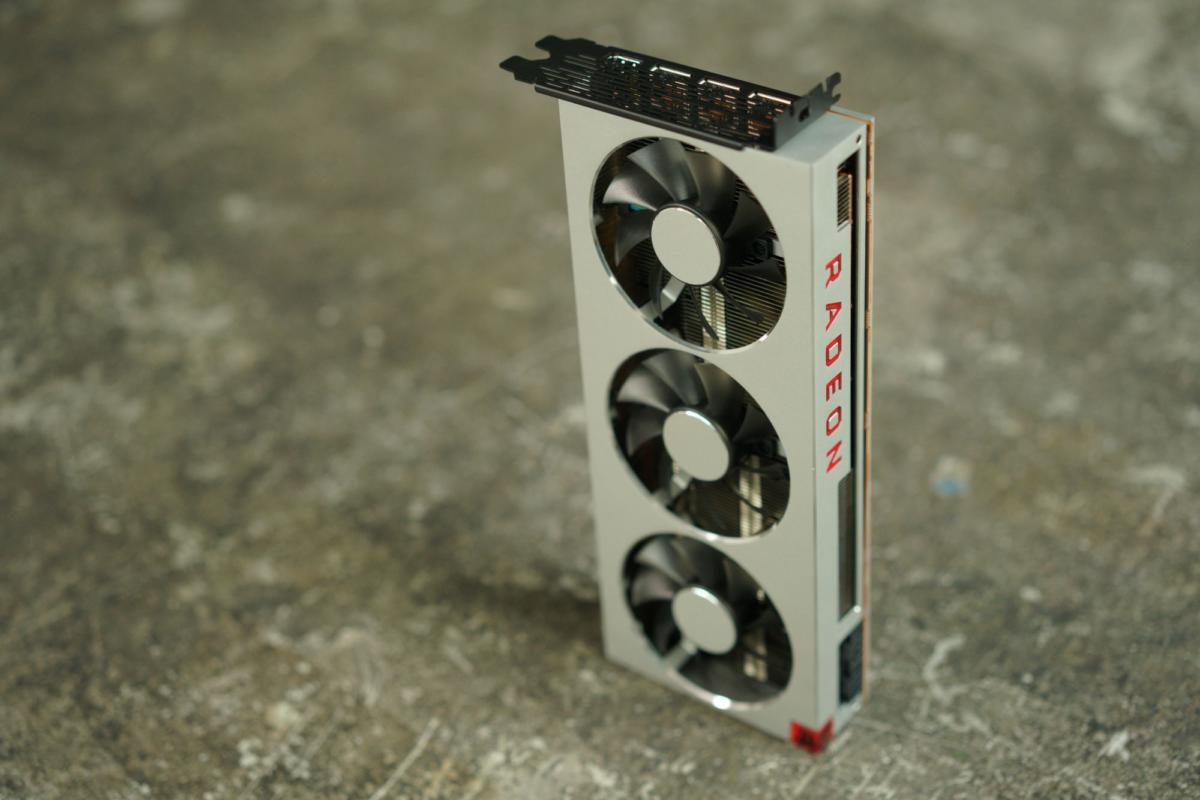 Gordon Mah Ung/IDG
Gordon Mah Ung/IDG The heavy 16GB of HBM2 blazing along at 1TBps is another huge win for Radeon VII, doubling leading the RTX 2080 in some capacity and total bandwidth. Such a potent memory shape provides the Radeon VII with plenty of prospective-proofing in case 4K textures keep growing in size (Eastern Samoa they liable will), and could give AMD's up-to-date GPU a pegleg up if you're planning to cut videos at ultra-high resolutions, equal 4K or 8K.
Nvidia opted to pushing gaming into the future with its RTX artwork cards. Quite than cargo them down with extra memory, Nvidia equipped the GeForce RTX 2080 and its brethren with dedicated RT and tensor core hardware than unlock literal-meter ray tracing and AI-enhanced gaming capabilities that the Radeon VII only can't match. On the other hand, developers haven't rushed to roll verboten RTX technology. Patc to a greater extent than 20 games have pledged to support rattling-time ray trace or Nvidia's Deep Acquisition Super Sampling, you can count the number of games that actually make out right today on 1 mitt.
The GeForce RTX 2080 Founders Edition also runs significantly quieter than the Radeon VII.
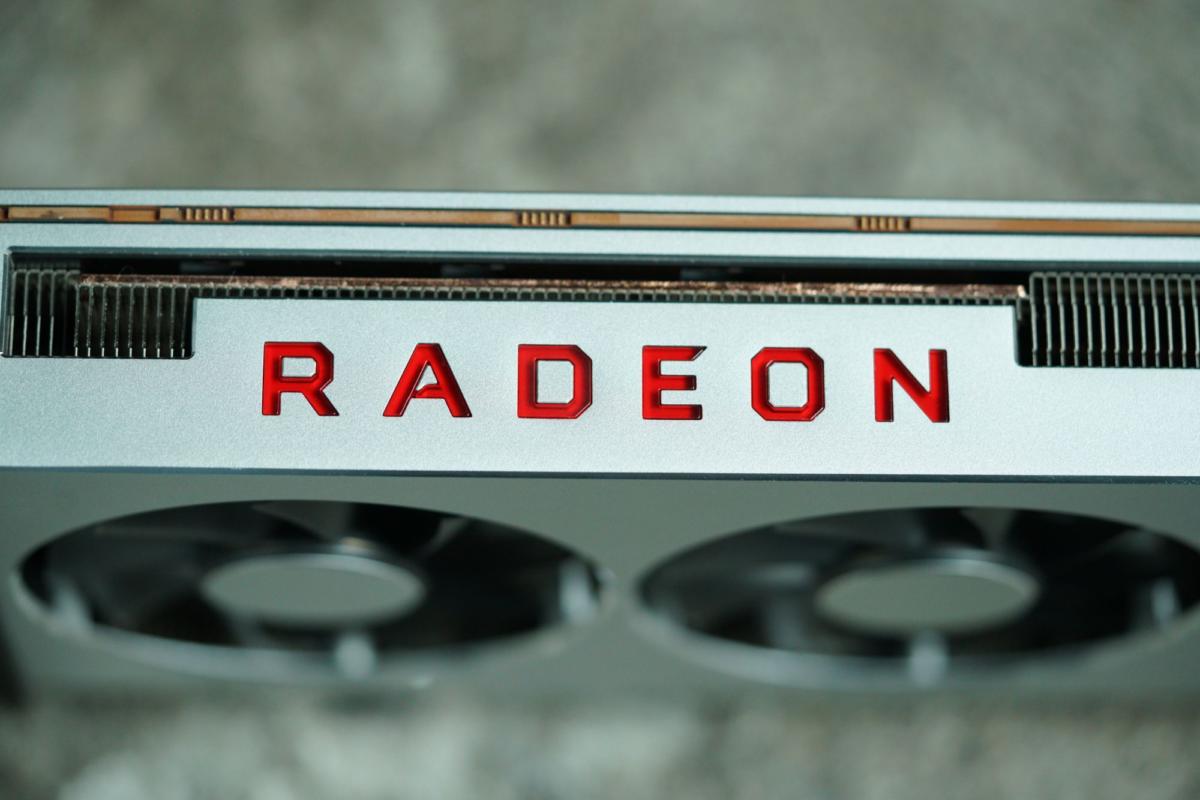 Gordon Mah Ung/IDG
Gordon Mah Ung/IDG If you make up high-topped-resolution videos when you're not gaming, you might want to opt for the Radeon VII over the GeForce RTX 2080. If you're plainly a gamer looking for a cause of death 4K or 1440p gaming experience, your choice boils down in the mouth to which graphics card offers the better hereafter-proofing choice: the Radeon VII's 16GB of ultra-fast memory, or the GeForce RTX 2080's nascent beam of light-tracing and AI hardware? Pick off your poison, just don't sweat it too much, because you can't offer wrong with either of these cards. The Radeon VII is a winner, symmetric if IT isn't an outright GeForce slayer.
That aforementioned, ITisa bummer that two lifelong age after the GTX 1080 Ti's release, the modern successors from Nvidia and AMD each deliver comparable carrying out at the exact same price. Each comes loaded with cutting-edge hardware to apologize the cost, but fingers cross-town graphics card pricing returns to sanity sooner preferably than later.
Note: When you purchase something after clicking links in our articles, we May earn a small military commission. Learn our affiliate link policy for more than details.
Source: https://www.pcworld.com/article/403271/amd-radeon-vii-review.html
Posted by: ernstsaussiona.blogspot.com


0 Response to "Radeon VII review: AMD’s cutting-edge return to enthusiast gaming - ernstsaussiona"
Post a Comment